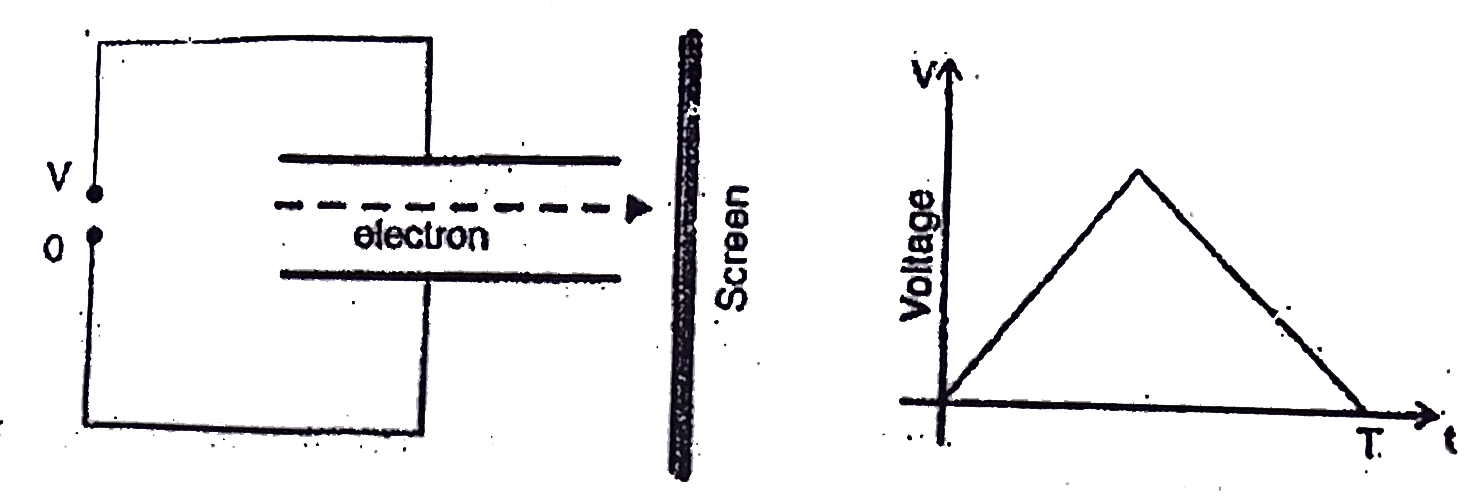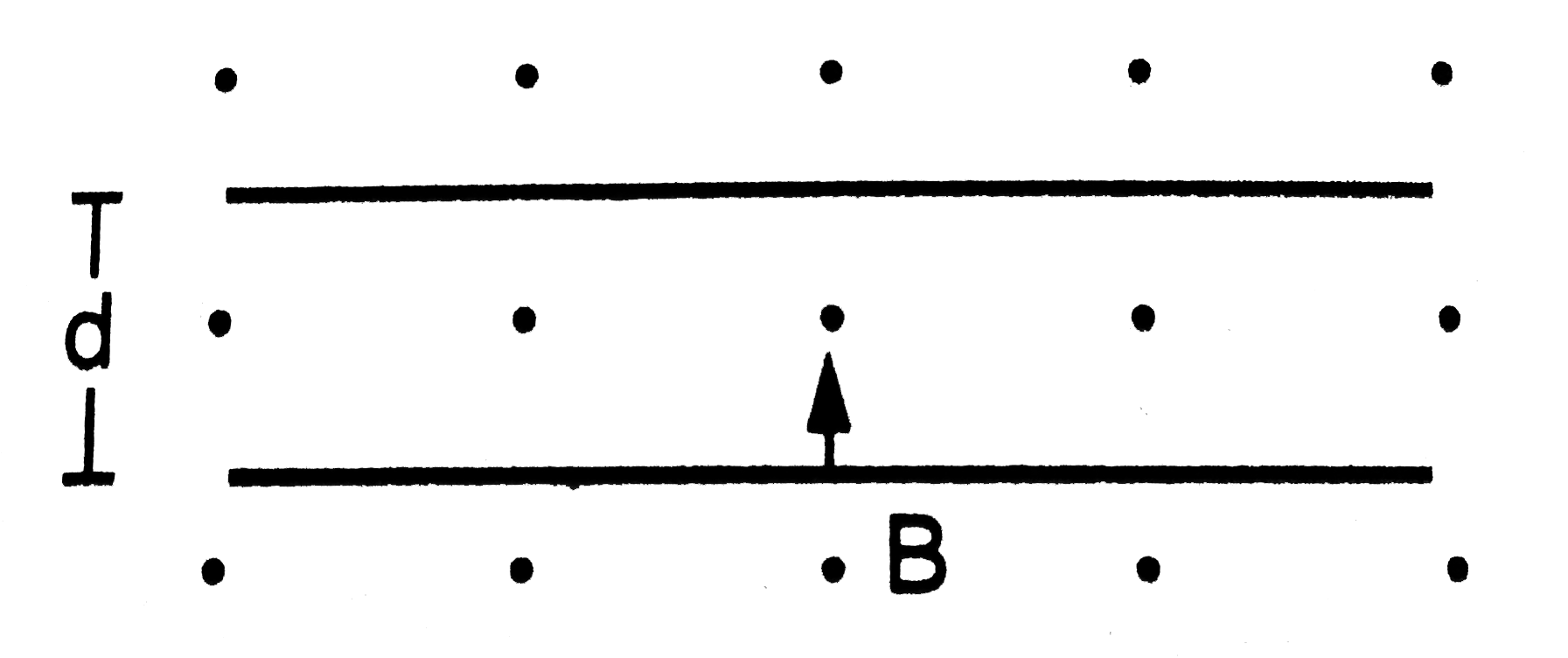An electron passes between two parallel plate of a capacitor as shown in the diagram. The electron enters the plate at t=0 and it comes out of the plates at time t=T. The electron hits the screen at A, as shown. Now a time varying potential difference V is applied between the plates, as shown in the graph. (Neglect the gravity). The point where the electron now will strike (as compared to point A) will be
 Solution in Gujrati
Solution in Gujrati
Deflected up
Deflected down
Deflected up then down
Deflected down then up
The correct Answer is:A
A positive potential on the upper plate attracts the electron and hence deflects it upwards since electric field between the plates is always downward i.e. force on electron is always upward i.e. force of electron is always upward). It would only be deflected downwards by a negative potential on the top plate.
Topper's Solved these Questions
- TEST PAPERSBOOK - ALLEN CHAPTER - TEST PAPERSEXERCISE - PAPER 3
92 Videos
- TEST PAPERSBOOK - ALLEN CHAPTER - TEST PAPERSEXERCISE - Part-1 Physics
15 Videos
- TEST PAPERSBOOK - ALLEN CHAPTER - TEST PAPERSEXERCISE - MATHS
1 Videos
- TEST PAPER 4BOOK - ALLEN CHAPTER - TEST PAPER 4EXERCISE - PHYSICS
45 Videos
- UNIT & DIMENSIONS, BASIC MATHS AND VECTOR BOOK - ALLEN CHAPTER - UNIT & DIMENSIONS, BASIC MATHS AND VECTOR EXERCISE - Exercise (J-A)
7 Videos
Similar Questions
A satellite S is moving in an elliptical orbit around the earth. The mass of the satellite is very small compared to the mass of the earth.
View SolutionA quantity of 2 mole of helium gas undergoes a thermodynamic process, in which molar specific heat capacity of the gas depends on absolute temperatureT , according to relation:
C=3RT4T0
where T0 is initial temperature of gas. It is observed that when temperature is increased. volume of gas first decrease then increase. The total work done on the gas until it reaches minimum volume is :-
View SolutionIf complex number z(z≠2) satisfies the equation z2=4z+|z|2+16|z|3, then what is the value of |z|4 ?
View SolutionTwo forces, each of magnitude F have a resultant of the same magnitude F. The angle between the two forces is
View SolutionMatch List I with List II and select the correct answer using the codes given below the lists :

View SolutionAn electron is emitted with negligible speed from th nagative plate of a parallel plate capacitor charged ot a potential difference V. The separtion between the plates is d and a magnetic field B exists in the space as shown in . Show that the electron will fail to strike the upper plate if ltdgt (2meVeB20)12.

View SolutionAn electron enters the region between the plates of a parallel plate capacitor at an angle theta to the plates. The plate width is l , the plate separation is d . The electron follows the path shown just missing the upper plate. Neglect gravity. Then,
View SolutionAn electron having charge e and mass m starts from the lower plate of two metallic plates separated by a distance d . If the potential difference between the plates is V , the time taken by the electron to reach the upper plate is given by .
View SolutionAt the moment t=0 on electron leaves one plate of a parallel-plate capacitor with a neglible velocity. An accelerting volatage, varrying as V=at, where a=100V/s is applied between the plates is l=5.0cm. What is the velocity of the of the electron at the moment it reaches the opposite plate?
View SolutionThe potential difference between two large parallel plates is varied as v = at, a is a positive constant and t is time. An electron starts from rest at t=0 from the plate which is at lower potential. If the distance between the plates is L, mass of electron m and charge on electron -e then find the velocity of the electron when it reaches the other plate.
View SolutionWhen potential difference of 9V is applied between the two plates, electron accelerate between the plates with velocity
View SolutionAt t=0 ,an electron leaves one plate of a parallel plate capacitor with negligible initial velocity.An accelerating voltage,varying as V= kt ,is applied between the plates.The separation between the plates is l ,velocity with which the electron reaches the opposite plate is ..?
View SolutionAt "t=0," an electron "(e,m)" leaves one plate of a parallel plate capacitor with negligible initial velocity.An accelerating voltage,varying as "V=kt," is applied between the plates.The separation between the plates is "l" ,velocity with which the electron reaches the opposite plate is
View SolutionThe potential difference between two parallel plates is 10^(4) V. If the plates are separated by 0.5 cm, the force on an electron between the plates is
View SolutionTwo long parallel plates A and B are separated by a distance of 4 cm with an electric field of 45 . 5 Vm^(-1) between the plates normally from plate A to plate B , as shown in the figure. An electron is projected from plate A with velocity v at an angle of 30^(@) with the surface of plate A . The maximum value of v so that the electron does not hit plate B is (Assume gravity free space, charge of electron = 1.6 xx 10^(-19) C and mass of electron = 9 . 1 xx 10^(-31) kg )
View SolutionA uniform magnetic field (B) is applied between the plates of a capacitor in the outward direction as shown in the figure. Surface charge density on the capacitor plates is sigma . An electron is fired in between the plates, parallel to them, as shown in the figure. The electron is found to move straight in-between the plates of capacitor. Neglect the gravity. If L is the length of the plates then caleulate the time taken by the electron to cross the plates.
View Solution
